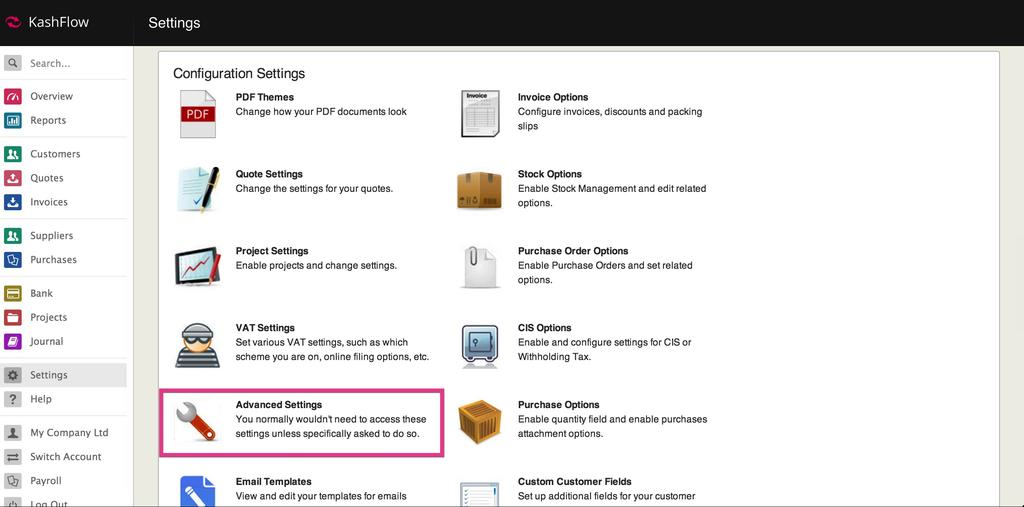Advanced settings
This topic explains the affect of the advanced settings options.
Go to Settings > Advanced Settings.
Advanced setting should be used with cation, some options will affect your reports. Contact support@kashflow.com if you need assistance with advanced settings

-
Start page - from the list, select the page you want see first when you log in.
-
Transaction Locking - use this option to enable global transaction locking. Global transaction locking will lock all transactions including invoices, purchases and payments on and before the date set from being modified or deleted.
-
Invoice Filename Format - set how invoices are named when they are exported.
-
Allow me to set the Invoice Filename format on a per-customer basis - select this option if you want to have different file name format for different customers.
-
Prevent me from re-using a Supplier Reference twice for the same supplier - selecting this option will compare the supplier reference that you enter with previously entered receipts. If there is already a receipt in IRIS KashFlow with that supplier reference then you won’t be able to enter in the receipt and will be alerted that is a duplicate.
-
Include the customers postcode wherever customers are shown in a list - choose to display postcodes in lists or not.
-
Bank Reconciliation - select this option to exclude older un-reconciled items.
Advanced VAT Settings
- Enable VAT Reconciliation - bring forward older, undeclared items to the current VAT Return - select this option and enter the VAT Reconciliation Start Date to hide transactions from before this date appearing on your VAT return.
The VAT Reconciliation Start Dateshould match the date that you’ve previously submitted VAT until. This should normally be the end date of your last submitted return.
Exclude invoices raised before the VAT reconciliation date but paid after it (only applicable for Cash Accounting) - select this option if you should include paid items from before the date or not.
Selecting the cash accounting box will mean that items issued before the VAT reconciliation date but after will not be included. For example;VAT rec date 15/01/2013. Invoice raised 01/01/2012, paid 01/02/2013 – this will not be included in the next return.
De-selecting the cash accounting box will mean that transactions raised before the VAT reconciliation date and paid after will be included on your next return.VAT rec date 15/01/2013. Invoice raised 01/01/2012, paid 01/02/2013 – this will be included in the
For Flat Rate Scheme turnover calculations, exclude any items with the VAT rate set to "n/a" - by default unselected; all your turnover (even turnover that has a VAT N/A rate set) is included in your VAT return. To only include items that you’ve classed as VATable (0% and above) tick this.
Let me set on a per-nominal basis which codes should be included as EC sales for VAT purposes - selecting this option allows you to set at a sales type level what items to appear on the EC Sales List. Normally the EC sales list is generated based on the customers EC status defined in the customer profile, using this option will generate the list based on the customers EC status defined in the customer profile and if the sales type is set to be included in the sales type settings.
Following the departure from the EU this no longer applies to businesses based in Great Britain (England, Scotland, and Wales). However, this is still valid for businesses based in Northern Ireland with suppliers in another EC member state.